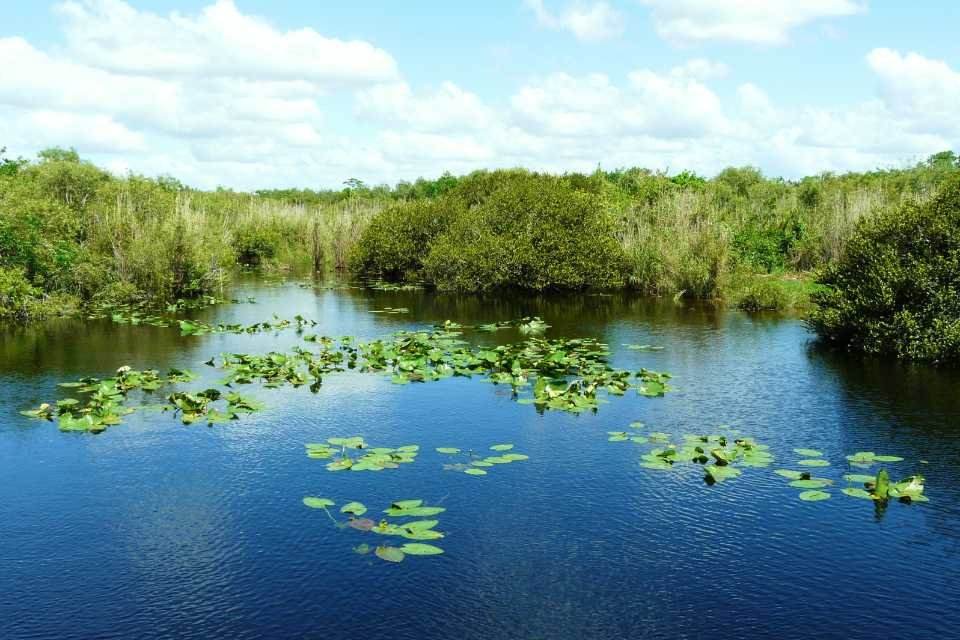Everglades National Park travel guide
Get the most out of your trip to the Everglades
The Everglades National Park is one of the biggest parks and conservation areas in the world, so it can be daunting to try and explore it. W'e’ve collected all the information you need to know before embarking on your trip to the park, along with a few pointers to help you enjoy your trip even more.
From what to pack, where to stay, and the best activities and sights to experience, this comprehensive guide will ensure you get the most out of your visit. So, what are you waiting for? Let’s dive into the ultimate Everglades National Park travel guide!
About the Everglades
The Everglades National Park is one of the most unique and diverse ecosystems in the world, located in the southernmost tip of Florida. Spanning an area of 1.5 million acres, the Everglades is home to a variety of plants and animals, including manatees, alligators, sea turtles, and over 350 species of birds. The wetlands are also the only place in the world where alligators and crocodiles can be found living together.
The region was first established as a National Park in 1947 with the aim of protecting this fragile ecosystem. Over the years, several preservation efforts have been put in place to keep the Everglades from further degradation. The park is now a UNESCO World Heritage Site, offering visitors a chance to experience its stunning beauty up close.
Whether you're looking for a serene nature hike, a thrilling airboat ride, or some time spent fishing and kayaking, the Everglades has something for everyone. With so much to explore and discover, it's no wonder that this iconic destination remains one of America's most beloved parks.
When to Visit
The best time to visit the Everglades National Park is during the winter and spring, which typically runs from November through April. During this time, temperatures are milder and the chances of rain are lower. The summer months (May through October) bring hotter and more humid weather, plus more frequent rainfall and the threat of hurricanes.
During the winter months, you can enjoy lots of wildlife-spotting opportunities, as many of the animals that migrate to the park for the cooler season. Birders can take advantage of peak bird migration times, which usually occur during March and April.
Since the Everglades are located in the southern region of Florida, it's important to be aware of mosquitos and other biting insects throughout the year, especially in the summer months. Be sure to bring bug repellent and wear light, loose clothing.
How to Get There
The Everglades National Park is located in southern Florida, and is accessible from Miami and the Florida Keys. The main entrance is located in Homestead, Florida.
The best way to get to the Everglades National Park is by car. From Miami or Fort Lauderdale, take Highway 1 South until you reach the park entrance. You can also access the park from the Florida Keys via U.S. Highway 41, which ends at the park’s Flamingo Visitor Center.
The closest airports to the Everglades National Park are Miami International Airport and Fort Lauderdale-Hollywood International Airport. From either airport, you can rent a car and drive to the park.
There are several public transportation options to get to the Everglades National Park, including the Miami-Dade Transit bus system, the South Florida Regional Transportation Authority's Tri-Rail commuter train, and Greyhound buses. All three offer service to Homestead, Florida, which is the closest town to the park entrance.
What to Expect
The Everglades National Park is one of the largest parks in the United States, and it's an amazing place to explore. The park encompasses nearly 2 million acres of wetland habitat and is home to a wide variety of wildlife.
When visiting the Everglades, you can expect to see a variety of animals such as alligators, manatees, dolphins, otters, and more. You can also expect to find unique plants such as cypress trees, mangroves, and sawgrass.
In addition to wildlife and vegetation, you can also expect to find plenty of opportunities for recreational activities. Popular activities include canoeing, kayaking, airboating, fishing, and birdwatching.
The Everglades are also home to numerous campgrounds, lodges, and resorts where visitors can stay and enjoy the park's many offerings. And for those who want to get closer to nature, there are plenty of backcountry camping sites available too.
No matter what you're looking for, you can expect a memorable experience when visiting the Everglades National Park. So don't wait any longer and start planning your trip today!
Top things to see and do in the Everglades
The Everglades National Park is a vast and stunning natural wonder, full of incredible sights and activities to explore. Here are some of the highlights that you can look forward to while visiting:
Take a canoe or kayak ride down a river in the park
There are several great rivers that meander through the park, including Shark River, Turner River, and Snake Bight. This is a great way to get up close and personal with the park's wildlife.
Go bird-watching
The Everglades National Park is home to over 350 species of birds, so you can be sure to spot something unique.
Visit an native village
Several small villages can be found in the park, with most of them operated by the Miccosukee tribe. Here, you'll get to learn about their culture and history.
Take a tram tour
A great way to get around the park is by taking a guided tram tour. You can get up close and personal with the wildlife and also learn a lot about the park's history.
Hike through the park
There are miles of trails that weave throughout the park, giving you plenty of opportunities for exploration. Keep your eyes peeled for rare and unique plants and animals.
Go camping
If you want to experience the Everglades fully, you should consider camping in the park overnight. There are several designated camping spots that offer great views and access to nearby attractions.
Fish
Fishing is allowed in most areas of the park and you may even be lucky enough to catch some bass or tarpon!
What to Pack
No matter the season, the weather in the Everglades National Park can be unpredictable. To ensure a successful visit, it’s important to come prepared with the right items for your trip. Here’s a helpful list of must-have items to bring along:
Clothing
Pack light, breathable clothing made of natural fibers. The Everglades can get very hot and humid during the summer months, so lightweight and loose-fitting clothes are ideal. Be sure to bring a hat or visor, long-sleeve shirts, and comfortable shoes. Remember to also bring a swimsuit if you plan on taking a dip in one of the park’s lakes.
Sun protection
With lots of direct sunlight, it’s essential to bring sunscreen and sunglasses. You might also want to bring a lightweight umbrella or raincoat in case of unexpected showers.
Insect repellent
Mosquitos, ticks, and other pesky insects are common in the Everglades, so don’t forget insect repellent.
First-aid kit
Make sure to pack a basic first-aid kit in case of minor injuries. Include sunburn treatment, lotions for insect bites and abrasions, and rehydration tablets.
Other necessities
A flashlight, binoculars, water bottles, snacks, a camera, and guidebooks are all recommended items for exploring the park. Don’t forget to bring plenty of cash too – many of the facilities at the Everglades National Park do not accept credit cards.
Where to Stay
When visiting the Everglades National Park, there are a few different options for where to stay. Depending on what kind of experience you are looking for and how long you plan on staying in the park, there are a variety of places available to accommodate your needs.
If you are looking for a more rustic experience, camping is a great option. The Flamingo Campground has campsites that accommodate both tents and RVs. Reservations are recommended as the sites fill up quickly during the peak season. Backcountry camping is also available with a permit from the visitor center.
For visitors who want a more luxurious experience, there are a few lodges and resorts located near the park. The Grand Palms Spa & Golf Resort provides guests with beach access and an 18-hole golf course, while the Vacation Village at Weston offers fishing, eco-tours, and airboat rides.
If you would rather stay in an urban area, Miami is only an hour away and provides plenty of accommodation options. Hotels, bed and breakfasts, and vacation rentals are all available in the city.
No matter what kind of experience you’re looking for, the Everglades National Park provides plenty of options when it comes to accommodations. Be sure to research ahead of time to find the best option for you.
Everglades FAQs
Q: Is there camping in the Everglades National Park?
A: Yes, there are two campgrounds within the park boundaries. The Long Pine Key Campground is open year-round, while Flamingo Campground is open from November through April.
Q: Are there alligators in the Everglades?
A: Yes, alligators can be found in the Everglades. It is important to remain cautious and respect the wildlife when visiting the park.
Q: How big is the Everglades National Park?
A: The Everglades National Park is 1.5 million acres and is the largest subtropical wilderness in the United States.
Q: Is there a fee to enter the park?
A: Yes, there is an entrance fee of $30 for a private vehicle for 7 days. A motorcycle fee is $25 for 7 days and a person on foot or bike is $15 for 7 days.
Q: What kind of activities can I do at the Everglades National Park?
A: Activities at the Everglades National Park include airboat tours, hiking, biking, kayaking, camping, fishing, bird watching, and much more.
Important information
Entrance fees to the Everglades National Park are $30 per vehicle, and good for 7 days. There is a daily entrance fee of $15 per person for visitors arriving by foot, bike, or bus. There is no fee for children under 16 years of age.
The Everglades is open 24 hours a day, 365 days a year, and can be visited at any time of day. Camping is allowed in certain designated areas with a permit.
Many areas of the Everglades are off-limits, so it’s important to stick to marked trails and obey park regulations. Swimming, wading and boating are all allowed in designated areas only.
It is illegal to feed or disturb wildlife in any way. Dogs are not permitted in the park except on paved roads, parking lots, and some designated camping areas.
Make sure to bring plenty of water, sunscreen, and insect repellent. For your safety, stay alert and watch out for alligators and other wildlife.
Top tips
Bring plenty of sunscreen and insect repellent
Wear lightweight clothing and closed-toe shoes
Take plenty of water to stay hydrated
Pack a hat and sunglasses for sun protection
Use insect repellent to avoid bug bites
Watch out for alligators and other wildlife
Don’t feed the animals
Be aware of the tides and currents
Follow the instructions of park staff
Make sure to bring a map and compass
Stay on designated trails to avoid getting lost
Have fun and take lots of pictures!
















